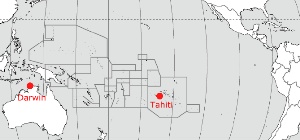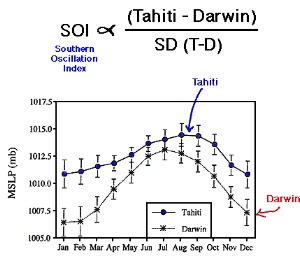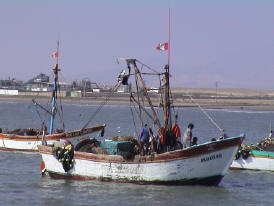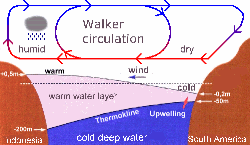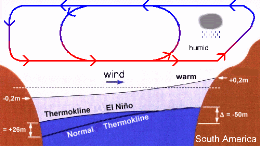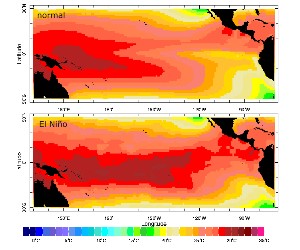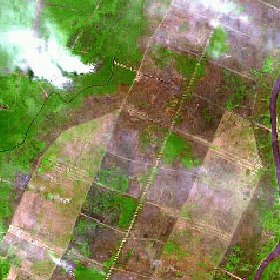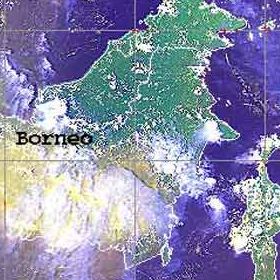 > English > Climate Encyclopaedia > Weather > more > 2. Major wind systems > - El Niño & SOI
> English > Climate Encyclopaedia > Weather > more > 2. Major wind systems > - El Niño & SOI
|
WeatherMore |
The Southern Oscillation and El NiñoSouthern OscillationThe fluctuations in ocean temperatures during El Niño and La Niña events are linked to even larger-scale fluctuations in air pressure between the western and eastern tropical Pacific known as the Southern Oscillation.
|
|
These pressure departures are reversed during La Niña, which features below-average air pressure over Indonesia and the western tropical Pacific and above-average air pressure over the eastern tropical Pacific.
ENSO has 3 phases: a warm phase known as El Niño, a cold phase called La Niña and neutral phase when neither El Niño or La Niña conditions occur.
|
|
Southern Oscillation Index (SOI)The Southern Oscillation Index (SOI) is a measure of the strength and phase of the Southern Oscillation. During El Niño episodes the SOI has a large negative value due to lower-than-average air pressure at Tahiti and higher-than-average air pressure at Darwin. During La Niña episodes, the SOI has a positive value due to higher-than-average air pressure at Tahiti and lower-than-average air pressure at Darwin. El Niño episodes occur in every 2-7 years.
|
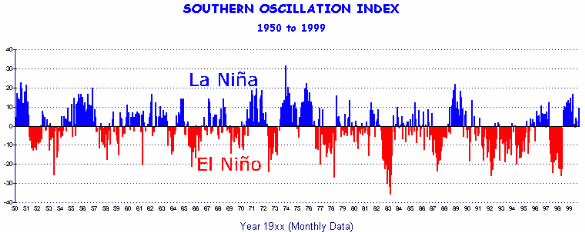 |
|
3. The southern oscillation index SOI. Strong negative red values stand for El Niño events, strong positive blue values stand for La Niña conditions. Please click the graph for a higher resolution.
|
 |
|
4. Sea Level Pressure 1960-1984
|
Historical review on El Niño eventsEl Niño is not a new phenomenon, it has been around for thousands of years. Chemical signatures of warmer sea surface temperatures and increased rainfall caused by El Niño appear in coral specimens at least 4000 years old, but some researchers claim to have found coral records that hold evidence of El Niño cycles more than a 100,000 years ago!
|
Records of El Niño events date back as far as the 1500's. At that time fisherman off the coast of Peru started noticing that periodic warm waters resulted in low anchovy catches. However, Peruvian farmers also noted that the warm waters lead to increased rainfall, transforming normally barren areas into fertile farmland. Between 1700 and 1900 European sailors made sporadic attempts at documenting the phenomenon and scientists became interested in identifying the cause.
|
|
|
It wasn't until the middle of the 20th century that the scientific causes of ENSO were worked out. Interest increased in the late 1960's and early 1970's and, using new observations including satellite data, climatologists and oceanographers recognised that El Niño events were much more than just a local feature of climate variability.
|
|
| |||||||
6. Nowadays we record conditions in the Pacific Ocean using fixed Atlas buoys which measure lots of different parameters, both at the surface and at depth. We also use drifting buoys, research ships, coastal tide gauge stations and make measurements of sea surface temperature from space using satellites. All this data forms an El Niño early warning system which helps people prepare for the next El Niño event.
|
|
|
|
El Niño events and consequences Between 1982 and 1983, a very strong El Niño caused havoc around the world. Associated floods,droughts & wildfires killed about 2,000 people worldwide. The damage caused was estimated at US$13 billion. An even stronger El Niño event developed in the Pacific between 1997 and 1998. Warnings were issued in mid 1997 and emergency preparedness conferences were convened. By March 1998, El Niño-related events globally caused US$34 billion of direct losses and killed 24,000 people. 111 million people were affected in some way and the related events left 6 million displaced people behind them.
|
|
Floods and fires are often a consequence of El Niño events. Smaller bush fires are normal in shifting cultivation areas, such as Indonesia. But sometimes it is also industrial burning, i.e. burning forest areas to enlarge plantations. Normally the heavy rain in December extinguishes all fires. But under El Niño conditions there is no rain. |
|
|
|
La Niña, on the other hand, can mean lots of rain in the following areas: South Asia (during monsoon times), North and North East Australia, South Africa, Northern South America, Central America, Hawaii.
|
About this page:author: Vera Schlanger - Hungarian Meteorological Service |
|
Further reading: http://whyfiles.org/
|

